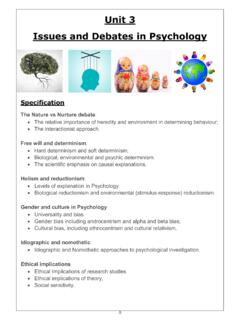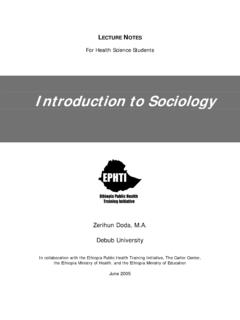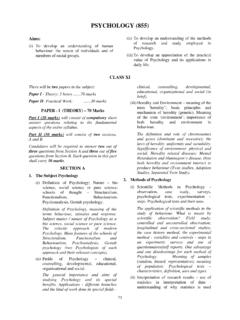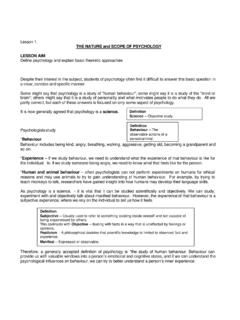Transcription of Dimensionalizing Cultures: The Hofstede Model in Context
1 Unit 2 Theoretical and Methodological Issues Article 8. Subunit 1 Conceptual Issues in Psychology and culture 12-1-2011. Dimensionalizing Cultures: The Hofstede Model in Context Geert Hofstede Universities of Maastricht and Tilburg, The Netherlands, Recommended Citation Hofstede , G. (2011). Dimensionalizing Cultures: The Hofstede Model in Context . Online Readings in Psychology and culture , Unit 2. Retrieved from This Online Readings in Psychology and culture Article is brought to you for free and open access (provided uses are educational in nature)by IACCP. and Copyright 2011 International Association for Cross-Cultural Psychology. All Rights Reserved. ISBN.
2 978-0-9845627-0-1. Dimensionalizing Cultures: The Hofstede Model in Context Abstract This article describes briefly the Hofstede Model of six dimensions of national cultures: Power Distance, Uncertainty Avoidance, Individualism/Collectivism, Masculinity/Femininity, Long/. Short Term Orientation, and Indulgence/Restraint. It shows the conceptual and research efforts that preceded it and led up to it, and once it had become a paradigm for comparing cultures, research efforts that followed and built on it. The article stresses that dimensions depend on the level of aggregation; it describes the six entirely different dimensions found in the Hofstede et al. (2010) research into organizational cultures.
3 It warns against confusion with value differences at the individual level. It concludes with a look ahead in what the study of dimensions of national cultures and the position of countries on them may still bring. This article is available in Online Readings in Psychology and culture : Hofstede : Dimensionalizing Cultures: The Hofstede Model in Context Introduction culture has been defined in many ways; this author's shorthand definition is: " culture is the collective programming of the mind that distinguishes the members of one group or category of people from others". It is always a collective phenomenon, but it can be connected to different collectives. Within each collective there is a variety of individuals.
4 If characteristics of individuals are imagined as varying according to some bell curve; the variation between cultures is the shift of the bell curve when one moves from one society to the other. Most commonly the term culture is used for tribes or ethnic groups (in anthropology), for nations (in political science, sociology and management), and for organizations (in sociology and management). A relatively unexplored field is the culture of occupations (for instance, of engineers versus accountants, or of academics from different disciplines). The term can also be applied to the genders, to generations, or to social classes. However, changing the level of aggregation studied changes the nature of the concept of culture '.
5 Societal, national and gender cultures, which children acquire from their earliest youth onwards, are much deeper rooted in the human mind than occupational cultures acquired at school, or than organizational cultures acquired on the job. The latter are exchangeable when people take a new job. Societal cultures reside in (often unconscious) values, in the sense of broad tendencies to prefer certain states of affairs over others ( Hofstede , 2001, p. 5). Organizational cultures reside rather in (visible and conscious) practices: the way people perceive what goes on in their organizational environment. Classifying Cultures: Conceptual Dimensions In an article first published in 1952, anthropologist Clyde Kluckhohn (1962) argued that there should be universal categories of culture : In principle.
6 There is a generalized framework that underlies the more apparent and striking facts of cultural relativity. All cultures constitute so many somewhat distinct answers to essentially the same questions posed by human biology and by the generalities of the human situation.. Every society's patterns for living must provide approved and sanctioned ways for dealing with such universal circumstances as the existence of two sexes; the helplessness of infants; the need for satisfaction of the elementary biological requirements such as food, warmth, and sex; the presence of individuals of different ages and of differing physical and other capacities. (pp. 317-18). Many authors in the second half of the twentieth century have speculated about the nature of the basic problems of societies that would present distinct dimensions of culture (for a review see Hofstede , 2001, pp.)
7 29-31). The most common dimension used for ordering societies is their degree of economic evolution or modernity. A one-dimensional ordering of societies from traditional to modern fitted well with the nineteenth- and twentieth-century Produced by The Berkeley Electronic Press, 2011 3. Online Readings in Psychology and culture , Unit 2, Subunit 1, Chapter 8. belief in progress. Economic evolution is bound to be reflected in people's collective mental programming, but there is no reason why economic and technological evolution should suppress other cultural variety. There exist dimensions of culture unrelated to economic evolution. anthropologist Edward T. Hall (1976) divided cultures according to their ways of communicating, into high- Context (much of the information is implicit) and low- Context cultures (nearly everything is explicit).
8 In practice this distinction overlaps largely with the traditional versus modern distinction. sociologists Talcott Parsons and Edward Shils (1951, p. 77) suggested that all human action is determined by five pattern variables, choices between pairs of alternatives: 1. Affectivity (need gratification) versus affective neutrality (restraint of impulses);. 2. Self-orientation versus collectivity-orientation;. 3. Universalism (applying general standards) versus particularism (taking particular relationships into account);. 4. Ascription (judging others by who they are) versus achievement (judging them by what they do);. 5. Specificity (limiting relations to others to specific spheres) versus diffuseness (no prior limitations to nature of relations).
9 Parsons and Shils (1951) claimed that these choices are present at the individual (personality) level, at the social system (group or organization) level, and at the cultural (normative) level. They did not take into account that different variables could operate at different aggregation levels. anthropologists Florence Kluckhohn and Fred Strodtbeck (1961, p. 12) ran a field study in five geographically close, small communities in the Southwestern United States: Mormons, Spanish Americans, Texans, Navaho Indians, and Zuni Indians. They distinguished these communities on the following value orientations: 1. An evaluation of human nature (evil - mixed - good).
10 2. The relationship of man to the surrounding natural environment (subjugation - harmony - mastery);. 3. The orientation in time (toward past - present - future);. 4. The orientation toward activity (being - being in becoming - doing); and 5. Relationships among people (linearity, , hierarchically ordered positions . collaterality, , group relationships individualism). Others have extrapolated Kluckhohn and Strodtbeck's (1961) classification to all kind of social comparisons, without concern for their geographic limitations without considering the effect of levels of aggregation, and without empirical support. 4. Hofstede : Dimensionalizing Cultures: The Hofstede Model in Context British anthropologist Mary Douglas (1973) proposed a two-dimensional ordering of ways of looking at the world: 1.







